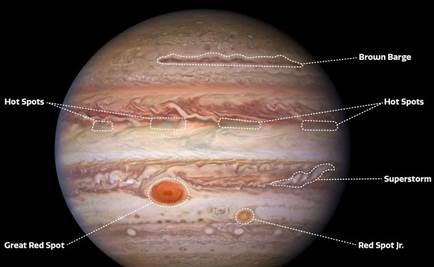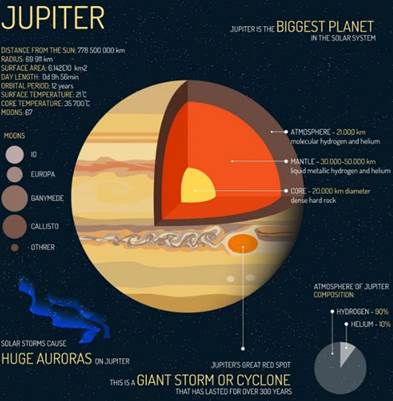Description

Disclaimer: Copyright infringement not intended.
Context
- The James Webb Space Telescope, NASA’s latest and most powerful Telescope, has captured new images of our solar system’s largest planet, Jupiter.
Details
- The photographs published have captured a new view of the planet, presenting in detail its massive storms, colourful auroras, faint rings and two small moons — Amalthea and Adrastea.
- Jupiter’s famous Great Red Spot, a storm so big that it could swallow Earth, appeared bright white in the image, since it was reflecting a lot of sunlight.
Jupiter
- Jupiter is the biggest planet in our solar system. It has big storms like the Great Red Spot, which has been going for hundreds of years. Jupiter is a gas giant and doesn't have a solid surface, but it may have a solid inner core about the size of Earth. Jupiter also has rings, but they're too faint to see very well.
Structure and Surface
- Jupiter is the biggest planet in our solar system.
- Jupiter is a gas giant. It is made mostly of hydrogen and helium.
- Jupiter has a very thick atmosphere.
- Jupiter has rings, but they’re very hard to see.
Time on Jupiter
- One day on Jupiter goes by in just 10 hours.
- One year on Jupiter is the same as 11.8 Earth years.

Jupiter's Neighbors
- Jupiter has 79 confirmed moons.
- Jupiter is the fifth planet from the Sun. That means Mars and Saturn are Jupiter’s neighboring planets.
Quick History
- Jupiter has been known since ancient times because it can be seen without advanced telescopes.
- Jupiter has been visited or passed by several spacecraft, orbiters and probes, such as Pioneer 10 and 11, Voyager 1 and 2, Cassini, New Horizons, and Juno.

James Webb Space Telescope
- The James Webb Space Telescope (JWST or "Webb") is a joint NASA–ESA–CSA space telescope that is planned to succeed the Hubble Space Telescope as NASA's flagship astrophysics mission.
- JWST will study various phases in the history of the universe, from the formation of solar systems to the evolution of our own Solar System.
- The telescope must be kept very coldin order to observe in the infrared without interference, so it will be deployed in space near the Sun–Earth L2 Lagrange point.
- Also a large sunshield made of silicon-coated and aluminium-coated Kapton will keep its mirror and instruments below 50 K (−223.2 °C).
Note
- A Lagrange point is a location in space where the combined gravitational forces of two large bodies, such as Earth and the sun or Earth and the moon, equal the centrifugal force felt by a much smaller third body.
- The interaction of the forces creates a point of equilibrium where a spacecraft may be "parked" without coming in the influence of gravitational field of any other body (example Earth or Sun).
To know more about Lagrange Points visit: https://www.iasgyan.in/blogs/types-of-orbits-explained
https://indianexpress.com/article/explained/explained-sci-tech/jupiter-like-never-seen-before-through-the-webb-telescope-8107843/
















